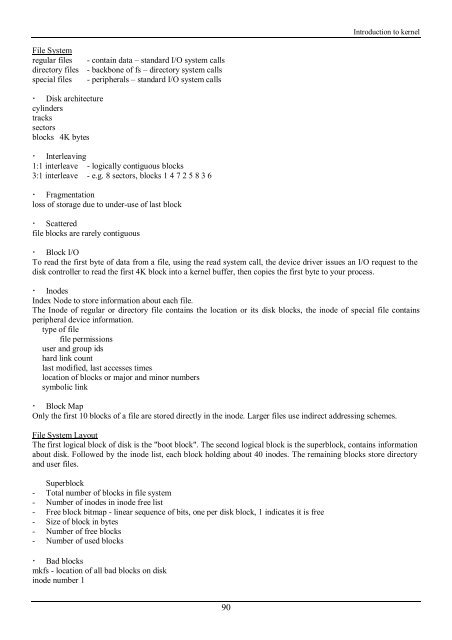Create successful ePaper yourself
Turn your PDF publications into a flip-book with our unique Google optimized e-Paper software.
Introduction to kernel<br />
File System<br />
regular files - contain data – standard I/O system calls<br />
directory files - backbone of fs – directory system calls<br />
special files - peripherals – standard I/O system calls<br />
! Disk architecture<br />
cylinders<br />
tracks<br />
sectors<br />
blocks 4K bytes<br />
! Interleaving<br />
1:1 interleave - logically contiguous blocks<br />
3:1 interleave - e.g. 8 sectors, blocks 1 4 7 2 5 8 3 6<br />
! Fragmentation<br />
loss of storage due to under-use of last block<br />
! Scattered<br />
file blocks are rarely contiguous<br />
! Block I/O<br />
To read <strong>the</strong> first byte of data from a file, using <strong>the</strong> read system call, <strong>the</strong> device driver issues an I/O request to <strong>the</strong><br />
disk controller to read <strong>the</strong> first 4K block into a kernel buffer, <strong>the</strong>n copies <strong>the</strong> first byte to your process.<br />
! Inodes<br />
Index Node to store information about each file.<br />
The Inode of regular or directory file contains <strong>the</strong> location or its disk blocks, <strong>the</strong> inode of special file contains<br />
peripheral device information.<br />
type of file<br />
file permissions<br />
user and group ids<br />
hard link count<br />
last modified, last accesses times<br />
location of blocks or major and minor numbers<br />
symbolic link<br />
! Block Map<br />
Only <strong>the</strong> first 10 blocks of a file are stored directly in <strong>the</strong> inode. Larger files use indirect addressing schemes.<br />
File System Layout<br />
The first logical block of disk is <strong>the</strong> "boot block". The second logical block is <strong>the</strong> superblock, contains information<br />
about disk. Followed by <strong>the</strong> inode list, each block holding about 40 inodes. The remaining blocks store directory<br />
and user files.<br />
Superblock<br />
- Total number of blocks in file system<br />
- Number of inodes in inode free list<br />
- Free block bitmap - linear sequence of bits, one per disk block, 1 indicates it is free<br />
- Size of block in bytes<br />
- Number of free blocks<br />
- Number of used blocks<br />
! Bad blocks<br />
mkfs - location of all bad blocks on disk<br />
inode number 1<br />
90
















